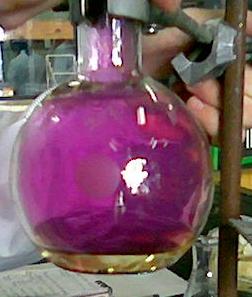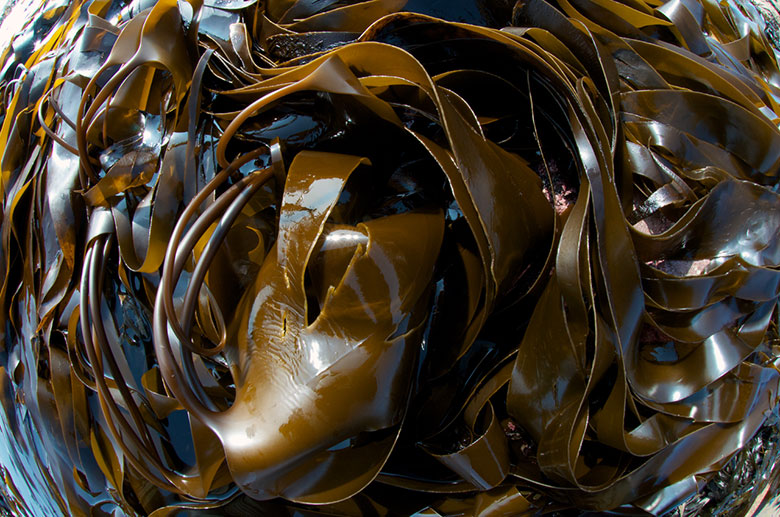Iodine in seaweeds
 Iodine, an essential element in human nutrition, is closely associated with seaweeds and the sea in the public perception. This is not surprising as iodine was first isolated by the French chemist Curtois in 1811 as a purple vapour (right) that arose after kelp ash from Brittany was treated with an excess of sulphuric acid. While Curtois suspected that it was a new element, it was not named until several years later by other French scientists, and Gay-Lussac chose "iode", derived from the Greek word for "violet-coloured", for the spectacular colour of iodine in a gaseous state (right). In its natural state iodine forms metallic-grey crystals.
Iodine, an essential element in human nutrition, is closely associated with seaweeds and the sea in the public perception. This is not surprising as iodine was first isolated by the French chemist Curtois in 1811 as a purple vapour (right) that arose after kelp ash from Brittany was treated with an excess of sulphuric acid. While Curtois suspected that it was a new element, it was not named until several years later by other French scientists, and Gay-Lussac chose "iode", derived from the Greek word for "violet-coloured", for the spectacular colour of iodine in a gaseous state (right). In its natural state iodine forms metallic-grey crystals.
Iodine is required for the production of two thyroid hormones essential in regulating human metabolism. The body does not of course make iodine, so it is an essential part of your diet but in very small quantities. Iodine is found in various foods, including many seaweeds. If you do not have enough iodine in your body, you cannot make enough of these thyroid hormones.

Seaweeds are an important source of dietary iodine but some important questions arise:
Can harm result from the high levels of iodine found in certain seaweeds? Yes, if the recommded levels in the table below are exceeded.
If such harm did occur could it be identifiable as deriving from consumption of a particular seaweed product? Probably.
Could a producer defend an action by saying that high iodine seaweeds have been eaten for long periods ? Not if appropriate warnings are not provided, although the principle of "caveat emptor" (buyer beware) applies. One should in particular be aware that "more of a good thing is not necessarily better."
Iodine levels in seaweeds vary in orders of magnitude from group to group and it is diccicult to generalise.
The key question is can you ensure that these iodine levels in humans are not exceeded? (It should be noted that some countries "iodise" table salt, and intake from this source should be taken into account.)
We recommend these levels, but please bear in mind that weight in indidual age classes could have considerable effects. For animals, levels should be about the same as for the equivales weight of humans.
| Age (years) | UL (µg/day) |
|---|---|
| 1-3 | 200 |
| 4-6 | 250 |
| 7-10 | 300 |
| 11-14 | 450 |
| 15-17 | 500 |
| Adult | 600 |
This information is provided as a guide and should not replace any professional advice. We appreciate the knowledge and experience of our good friend and colleague Dr Julian Clokie in making this page.





